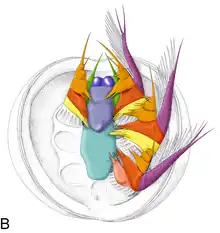Comley Limestone
The Comley Limestone is an Early Cambrian Lagerstätte exposed in Comley, Shropshire, England. It is known for its phosphatic microfossils, which can be extracted by acid maceration and are preserved in three dimensions in a similar fashion to the Orsten fossils.[1] It represents around 10 million years of deposition, and was deposited from 519 to 501 million years ago.[2] Fossils from the formation include the phosphatocopine arthropod Klausmuelleria.[3]
| Comley Limestone | |
|---|---|
| Stratigraphic range: 519-509 Ma | |
| Location | |
| Location | Comley, Shropshire, UK |

Drawing of Klausmuelleria a fossil phosphatocopine arthropod known from the unit
See also
References
- "'Orsten' on World-Wide Scale". www.core-orsten-research.de.
- Harvey, T. H. P.; Williams, M.; Condon, D. J.; Wilby, P. R.; Siveter, D. J.; Rushton, A. W. A.; Leng, M. J.; Gabbott, S. E. (2011). "A refined chronology for the Cambrian succession of southern Britain". Journal of the Geological Society. 168 (3): 705–716. Bibcode:2011JGSoc.168..705H. doi:10.1144/0016-76492010-031. S2CID 129176046.
- Siveter, David J.; Williams, Mark; Waloszek, Dieter (20 July 2001). "A Phosphatocopid Crustacean with Appendages from the Lower Cambrian". Science. 293 (5529): 479–481. doi:10.1126/science.1061697. ISSN 0036-8075.
This article is issued from Wikipedia. The text is licensed under Creative Commons - Attribution - Sharealike. Additional terms may apply for the media files.